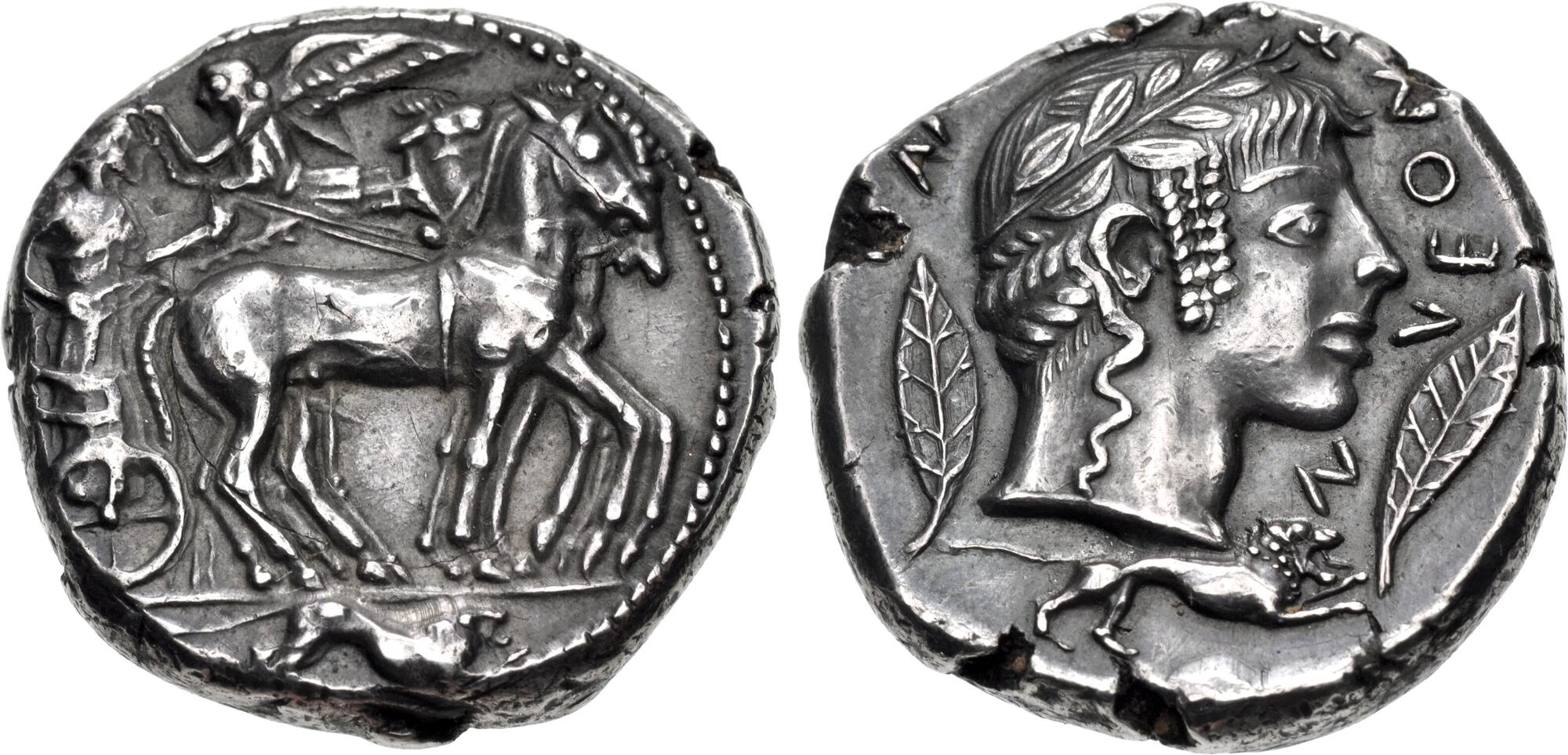Leontini, silver, tetradrachms (quadriga/head of Apollo with three leaves) (466-455 BCE)
From SILVER
466 BCE - 455 BCE Silver 660 kg
Description
| ObverseInscription or printing placed on the obverse.: | Charioteer, holding kentron in right hand and reins in both, driving slow quadriga right, above, Nike flying left, crowning charioteer with open wreath held in both hands, in exergue, lion right |
| ReverseInscription or printing placed on the reverse.: | ΛΕΟΝΤΙ - ΝΟ- Ν (Greek).Head of Apollo right, wearing laurel wreath, three leaves, below, lion right. |
Mint and issuing power
| MintIdentifies the place of manufacture or issue of a numismatic object.: | Leontini | Ancient regionAncient region.: | Sicily | Modern countryModern country: Italy | AuthorityIdentifies the issuing power. The authority can be "pretended" when the name or the portrait of X is on the coin but he/she was not the issuing power. It can also be "uncertain" when there is no mention of X on the coin but he/she was the issuing power according to the historical sources: |
Chronology
| FromIdentifies the initial date in a range assigned in a numismatic context. | 466 BCE | toIdentifies the final date in a range assigned in a numismatic context.. | 455 BCE | PeriodTime period of the numismatic object.: Classical 480-323 BC |
Physical description
| MetalThe physical material (usually metal) from which an object is made.: | Silver |
Median weightMedian of the weights of numismatic objects (in grams). in grams | 17.20 | DenominationTerm indicating the value of a numismatic object. Examples: tetradrachm, chalkous, denarius.: | tetradrachm |
StandardStandard.: | Attic |
Image

Leontini_466_D15_D16.jpg [1]
References
| Die study referencePublication of the study: | Maltese 20231Maltese 2023, p. 179-182, n° 48-50 | ||
| Coin series referenceReference to coin series study: | HGC 22HGC 2, n° 665 | ||
| Coin series web referenceCoin series web references: | |||
Obverse dies distribution
| FrequencyFrequency of specimen in distribution. ᵖ | Number of obversesNumber of obverse dies. ᵖ (o) | % (o) | Number of coinsNumber of coins. (n) | % (n) | Die nameName(s) of the die(s). |
| 19 | 1 | 50 | 19 | 28.79 | 15 |
| 47 | 1 | 50 | 47 | 71.21 | 16 |
| Total | 2 of 2 | 100 | 66 of 66 | 100 |
Reverse dies distribution
no distribution is available
Quantification
| Number of obversesNumber of obverse dies. ᵖ (o) | 2 | Number of singletons (o1)The number of singleton coins. ᵖ | 0 |
| Number of reverse diesNumber of reverse dies. (r) | 2 | Number of coinsNumber of coins. (n) | 66 |
| Coins per obverse dieNumber of coins per obverse die. (n/o) | 33 | Coins per reverse dieNumber of coins per reverse die. (n/r) | 33 |
| Reverse per obverse ratioRatio of obverse dies divided by reverse dies. (r/o) | 1 | Percentage of singletons (o1)number of coins (n) divided by the number of singletons (o1) ᵖ | 0 % |
| Original number of dies (O) (Carter 1983 formula)The estimation of the number of coins according to Carter 1983 ᵖ | 1.92 | Coins struck if 20,000 as average productivity per dieCoins made if the average productivity for obverses (according to Carter) is 20,000. ᵖ | 38,400 |
| Original number of dies (O) (Esty 2011 formula)The estimation of the number of coins according to the singleton formula in Esty 2011 ᵖ (O) | 2.06 | Survival rate if 20,000 as average productivity per dieSurvival rate if average productivity is 20,000. ᵖ | 0.00172 |
| Coverage (o = % of O) (Esty 1984 formula)Esty 1984 - coverage (% of O) ᵖ (o = % of O) | 100% | Die productivity if survival rate 1/2,000Average productivity if survival rate is 1/2,000. ᵖ | 68,750 |
| Weight of silver (in kg) if 20,000 coins per die (O = Carter formula)Carter 1983 * Median weight * 20000 (*10 if gold or electrum) ᵖ | 660 kg <br /> 660 kg | Die productivity if survival rate 1/5,000Average productivity if survival rate is 1/5,000. ᵖ | 171,875 |
Remarks
Most likely one single workstation
References
- ^ Maltese, Sebastiano (2023), I tetradrammi di Leontinoi. Dinamiche produttive e storico-artistiche, Trieste, Edizioni Università di Trieste, 338 p., XXXII pl.
- ^ Hoover, Oliver D. (2012), The Handbook of Greek Coinage Series. 2. Handbook of the Coins of Sicily (Including Lipara). Civic, Royal, Siculo-Punic, and Romano-Sicilian Issues. Sixth to First Centuries BC, Lancaster-London, 489 p.